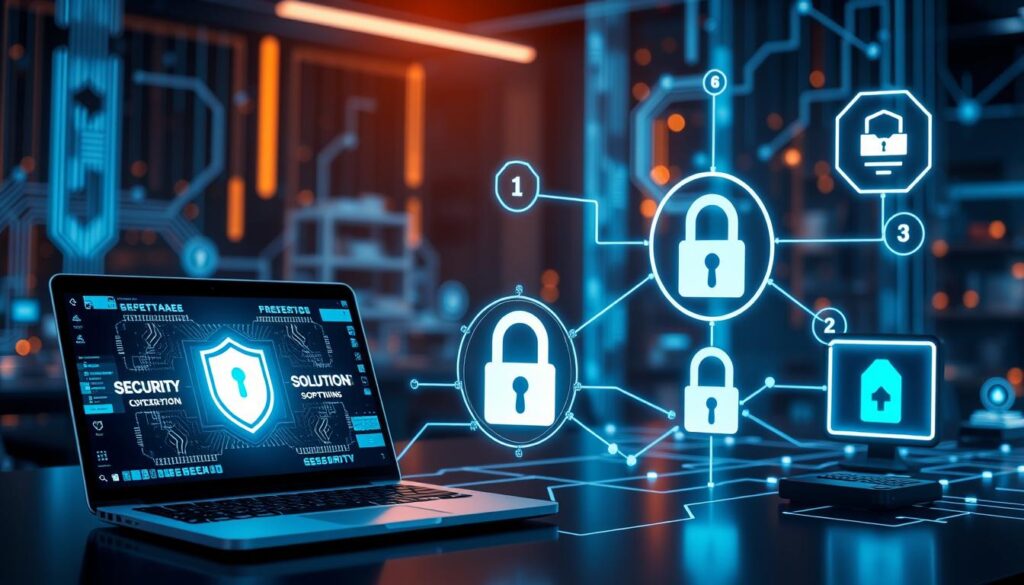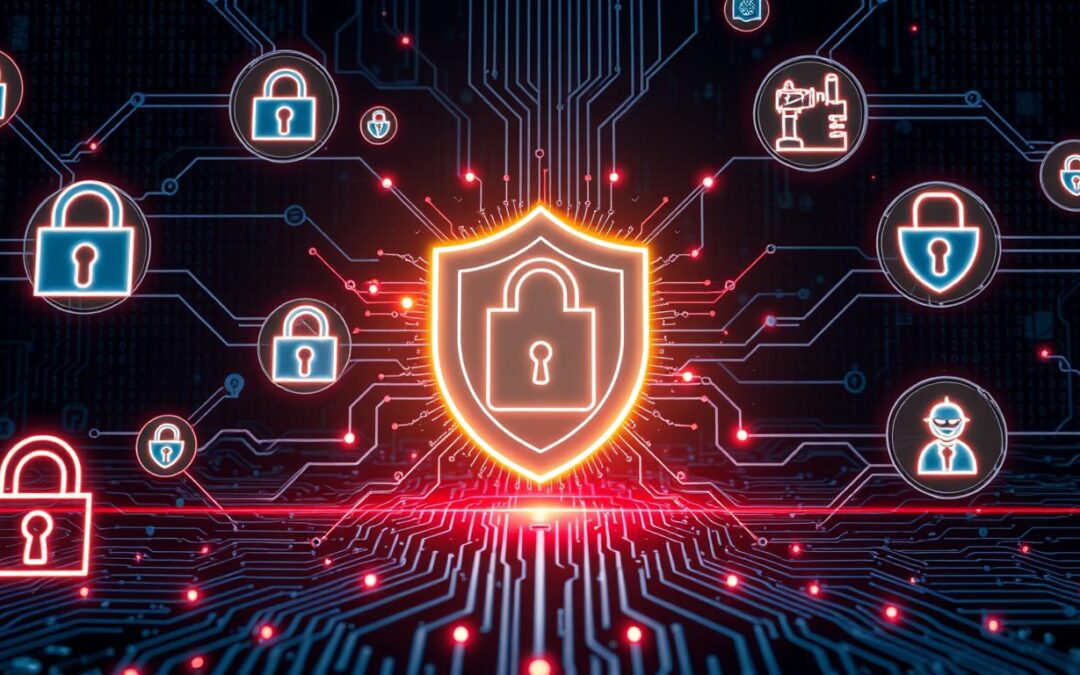In today’s world, we use technology more than ever. It’s key to keep our online lives safe. We must protect our personal info from cyber threats.
Using digital platforms makes us vulnerable to threats like data breaches and identity theft. Simple steps can boost our digital security. This way, we keep our data safe from cyber attacks.
About 81% of data breaches happen because of weak passwords. And 60% of people face phishing scams. It’s crucial to act now to protect our digital lives. By focusing on cybersecurity, we can lower the risk of cyber attacks.
Key Takeaways
- Prioritize online safety and take proactive steps to protect personal information
- Implement simple yet effective cybersecurity strategies to enhance digital security
- Use robust network security measures to protect against cyber threats
- Ensure robust data protection measures are in place to safeguard personal and professional data
- Stay informed about the latest cyber threats and updates to stay ahead of potential threats
- Regularly update software and operating systems to prevent malware infections
- Use strong passwords and consider multifactor authentication to block account compromise attempts
Understanding Modern Cybersecurity Threats
As we explore the digital world, it’s key to grasp the changing nature of cyber threats. Internet security now means protecting more than just our computers. It’s about keeping our whole online world safe. With more information security breaches, we all need to watch out for cyber attacks.
Cybercrime is expected to cost $10.5 trillion a year by 2025. This shows we need strong IT security plans. Common attacks like phishing, malware, and ransomware can steal our personal and financial info. This can lead to big losses and harm our reputation.
To beat these threats, we must know about new dangers. This includes attacks powered by artificial intelligence, which can trick old security systems. By keeping up with cybersecurity news, we can protect ourselves and our groups.
Common Types of Cyber Attacks
- Phishing attacks, which accounted for 36% of all data breaches in 2020
- Ransomware attacks, which have surged by 150% in 2021
- Malware attacks, which can compromise our personal information and financial data
Knowing these threats and how to stop them helps keep our digital lives safe. It keeps our important info from falling into the wrong hands.
Essential Password Protection Strategies
Strong password protection is key to keeping your data safe. A good password is 12 to 16 characters long. It should have letters, numbers, and symbols to make it hard to guess.
It’s important to use different passwords for each account. This way, if one password is hacked, others won’t be. Using a password manager can also help. It can create and keep complex passwords safe. Plus, it checks if your passwords have been stolen online.
- Using a password manager to generate and store complex passwords
- Implementing regular password changes, ideally every three months
- Avoiding the use of common phrases or words that can be easily guessed
- Enabling two-factor authentication whenever possible
By following these tips, you can lower the chance of your passwords being hacked. This helps keep your online identity safe. It’s a big part of keeping your digital world secure.
Multi-Factor Authentication: Your Digital Shield
In today’s world, keeping our digital lives safe is crucial. Multi-factor authentication (MFA) is a key part of this. It adds an extra layer of security by asking for a second form of verification. This can be through SMS, authenticator apps, or biometrics, all helping to protect our data.
Setting up MFA on sites like Google and Facebook is easy. It offers many benefits, like better security and less chance of password breaches. With MFA, we can greatly improve our online safety and keep our personal and work data safe from hackers.
Types of Multi-Factor Authentication
There are different kinds of MFA:
- Knowledge-based methods, like passwords and PINs
- Possession-based methods, such as security keys and tokens
- Inherence-based methods, like biometric authentication
Benefits of Enhanced Authentication
MFA helps make our networks more secure. It reduces the risk of data loss. By using MFA, we can keep our digital lives safe from threats. It’s a vital part of keeping our data safe and following cybersecurity best practices.
Securing Your Home Network
Protecting your digital life starts with securing your home network. With more devices connected to the internet, your network is at risk. Network security and internet security are key to keep your network safe and your personal info secure.
To boost your network’s security, change your router’s default password. Also, use a guest network for visitors. These steps can greatly lower cyber attack risks. Make sure your Wi-Fi password is strong and unique, and use WPA3 encryption for extra protection.
Here are some important stats on why securing your home network is crucial:
- 80% of routers are left with default usernames and passwords, making them vulnerable to cyberattacks.
- Only 45% of users regularly update their router firmware to protect against known vulnerabilities.
- 60% of households have at least one Internet of Things (IoT) device, which increases the potential attack surface for home networks.
By following these simple steps, you can greatly reduce cyber attack risks. Remember, internet security is everyone’s responsibility. Securing your home network is a big part of it.
Best Practices in Cybersecurity for Daily Internet Use
Protecting our digital lives is key. We must practice safe browsing habits. This means avoiding suspicious links and websites to dodge malware and phishing.
IT security steps, like checking email authenticity and using two-factor authentication, safeguard our personal and financial info.
Safe Browsing Habits
Safe browsing starts with using trusted antivirus software. Keeping our operating systems and browsers updated is also vital. This shields us from malware and cyber threats.
Being careful with links and attachments from unknown sources is crucial. It helps prevent phishing attacks.
Email Security Measures
Strong passwords and two-factor authentication are key for email security. They protect our accounts from cyber threats. We should also be wary of emails from unknown senders.
Staying cautious with links and attachments is important. This way, we can avoid phishing and other cyber attacks.
By following these cybersecurity best practices, we boost our digital security. This protects our personal and professional data from cyber threats. Using cybersecurity solutions and IT security measures is essential.
Data Encryption and Backup Solutions
Today, protecting your data is more important than ever. Regular backups and secure storage can save your data from cyber attacks or hardware failures. Using encrypted hard drives or cloud storage can greatly lower the risk of losing your data.
Encryption is a key part of data protection. Algorithms like AES-256 keep your data safe from unauthorized access. Also, using strong passwords for encrypted files adds extra security. It’s important to remember that backups and security measures should go hand in hand to recover data in emergencies.

- Using cloud-based backup solutions that provide additional layers of security
- Implementing encryption algorithms, such as AES-256, to secure data
- Utilizing unique and complex passwords for encrypted archives
- Regularly updating and patching software to prevent vulnerabilities
By following these steps and using strong cybersecurity measures, you can keep your data safe and secure.
Mobile Device Security Essentials
Our mobile devices are key to our daily lives, making their security vital. Cybercrime is on the rise, so we must take steps to keep our devices safe. Keeping your OS up to date is crucial, as old software is a hacker’s dream.
Using a password manager helps create strong, unique passwords. This makes it harder for hackers to guess them. It’s a simple way to boost your device’s security.
Internet security and information security are at the heart of mobile device protection. Enable automatic updates and use a VPN on public Wi-Fi.
Here are some important tips for mobile device security:
- Use a strong password or biometric login to keep your device safe from unauthorized access.
- Check and limit app permissions to avoid data breaches and malware.
- Be careful with public Wi-Fi, as 91% of people know it’s a big security risk.
By following these tips and staying up to date with cybersecurity threats, you can safeguard your digital identity. This ensures strong internet and information security for your mobile devices.
Identity Theft Prevention Measures
Protecting our digital lives from identity theft is key. We should keep an eye on our personal info, like credit reports and financial statements. This helps spot and stop identity theft early.
Being careful with online deals is also important. Use strong passwords and two-factor authentication to avoid data breaches and financial loss.
Here are some ways to stop identity theft:
- Regularly check your credit reports for odd activity
- Make sure all your online accounts have strong, unique passwords
- Turn on two-factor authentication whenever you can
- Be careful when sharing personal info online
By following these steps, we can lower the risk of identity theft. It’s vital to stay updated on cybersecurity best practices and watch out for personal info online.
Stopping identity theft needs both cybersecurity best practices and data protection steps. By doing these, we can keep our digital lives safe and avoid financial harm.
Training Family Members in Digital Security
More homes now have internet-connected devices, making cybersecurity a family issue. Kids as young as 2 can use tablets and smartphones. This shows the need for teaching digital security early. About 60% of parents worry about their kids facing online threats like identity theft and cyberbullying.
Using cybersecurity solutions can lower attack success by up to 35%. Families with strong Wi-Fi passwords are 80% less likely to face unauthorized access. Updating software and devices regularly can prevent 90% of cyber attacks, which exploit known vulnerabilities.
It’s key to involve everyone in digital security talks. Only 25% of families do this, showing a need for more collective effort. By taking steps and using online safety programs, families can boost their digital security and protect their online identities.

Online safety programs, like the FBI’s Safe Online Surfing, offer fun games for kids. These games teach safe internet use. By being proactive and using cybersecurity solutions and IT security, families can lower cyber attack risks and safeguard their personal and financial info.
Conclusion: Building a Sustainable Security Mindset
Creating a strong cybersecurity best practices mindset is key to protecting our digital world. By using the solid security steps shared in this article, we can fight off new data protection dangers. This helps keep our personal and work info safe.
Keeping up with the newest cybersecurity news and improving our security plans helps us outsmart hackers. It’s important to have regular security training, clear rules, and strong leadership support. These things help build a security-aware community and workplace.
Working together, we can build strong defenses and keep our digital lives safe. By having a lasting security mindset, we can confidently explore the digital world. We can enjoy its many benefits while keeping cyber threats at bay.

